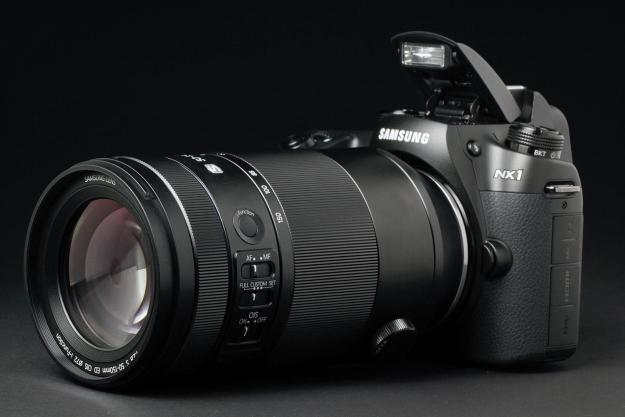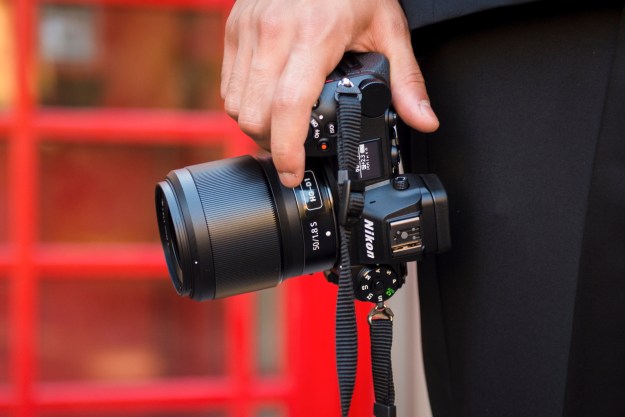
“With the NX1, Samsung proves it can build a camera. It is the best APS-C model we’ve reviewed to date.”
- One of the best APS-C cameras reviewed yet
- Captures 4K videos directly to media card
- Fast response, speedy focusing
- Limited number of S-series lenses
- Doesn’t have DSLR stamina (for burst modes)
- Heavier than other mirrorless models
If you’re looking for Samsung’s digital imaging flagship, the search simply ends with the NX1 ($1,500 MSRP, body only). This is the company’s top mirrorless interchangeable lens camera (ILC) – by far – and is loaded to the gills with just about everything Samsung could put into a camera other than a complete Galaxy smartphone. This camera is terrific and very impressive – something to look at if you want to shoot 4K content – and demonstrates how far Samsung has come in camera manufacturing.
Features and design
One of the top-line features of the new NX1 is a 28.2-megapixel APS-C sensor. The backside-illuminated (BSI) chip is the most pixel-packed of any in this category. The next step up is a camera with a full-frame sensor like the still available Sony A7, which is a bit cheaper at $1,299 (body only) but is a year older. But one area the NX1 beats the A7 is in video quality. Here, you can capture Cinema 4K and
The dust- and weather-resistant mirrorless camera has a magnesium-alloy frame and looks just like a DSLR, but it is just a shade thinner and shorter than an enthusiast DSLR like the Canon EOS 7D Mark II. It measures 5.45 x 4.0 x 2.6 inches and weighs 19.4 ounces (just the body). Add a battery and one of Samsung’s new S-series lenses (as we did with the 50-150mm telephoto) and you’re carrying serious weight. You’ll need proper bracing technique with this rig – even the lens’ built-in optical image stabilization can only do so much. The all-black body has a nicely textured finish and the grip has a comfy feel; as always, try it in your own hands before buying.

The key feature on the front is the NX mount. Samsung has more than a dozen reasonably priced lenses available, but the S-series glass is designed especially for the NX1. Along with the i-Function f/2.8 50-150mm S lens ($1,599), there’s also an i-Function f/2.8 16-50mm S lens for $1,299, with more planned for the future; no one said serious photography is cheap. The company also offers a NX1 kit with a battery grip, 16-50mm S lens, additional battery, and external charger for $2,799. This kit is clearly targeted to pros that need the extra juice and stability.
Other items on the front of the NX1 include an AF Assist lamp for improved focus in low light; depth-of-field preview and lens release buttons; and a speaker.
Samsung’s NX cameras tend to cater to new ILC photographers, but a quick glance at the top deck and you’ll immediately know this is an enthusiast’s camera. It has a small monochrome LCD readout to check your settings – just like higher-end DSLRs – and a variety of dials to access imaging parameters (ISO, shutter speed, exposure compensation, aperture, white balance, etc.) at a touch. The LCD is a bit smaller than those found on DSLRs simply because the NX1 body is smaller. Lenses equipped with i-Function (like the aforementioned) let you quickly make changes to image parameters (pressing the button brings up a special menu on the color LCD or EVF) but the physical dials and buttons might have more appeal for advanced shutterbugs.
The NX1 is possibly finest APS-C camera we have ever tested.
On top and to the left is a double-decker dial; turn it and it changes the burst rate or enables bracketing and the self-timer. Note: The top burst speed is 15 frames per second (fps) at full resolution, which is far more than the 10 fps of the Canon EOS 7D Mark II, but performance in real-use isn’t the same (we’ll explain more below). Also on the top are buttons to access ISO, metering, white balance, and focus type. As befits a high-end ILC the top shutter speed is 1/8,000th of a second, and ISO sensitivity reaches 51,200. A hot-shoe sits behind the pop-up flash and the nearby main mode dial has the typical shooting choices (auto, PASM, two custom options, and so on). Rounding out the buttons are exposure compensation, movie record, shutter, and on/off lever.
The two big features on the back are the 3-inch tilting AMOLED touchscreen (resolution rated at a very high 1,036K dots) and an even higher-res 2,360K-dot XGA electronic viewfinder (EVF) with a diopter control. Both are about as good as it gets in 2014. You can manually switch between them by pressing the EVF key or the eye sensor can do the job if you leave it in EVF Auto. During our test period we had few issues with the big screen but when we did, the viewfinder, which is surrounded by a very comfortable rubber ring, stepped up to the job. Alongside the LCD and EVF are the typical enthusiast camera buttons.
The NX1 has a Wi-Fi button to link to your smartphone or tablet. It uses the latest technologies including Wi-Fi 802.11ac and Bluetooth 3.0, making it one of the few cameras with this level of wireless connectivity. It makes the pairing process easier. We shouldn’t expect anything less from Samsung’s flagship, given its position in the

The right side has an NFC tag (to pair with NFC-equipped devices, which are mainly Android-based phones) and a single SD card slot. This is about the only feature that doesn’t rank with high-end cameras that typically have two slots. Some pro-level users may take issue with it, but we didn’t miss it, even after shooting tons of stills and videos over the course of three weeks on a 32GB UHS-I card.
On the left are connections for headphones, an optional mic, HDMI, and USB 3.0. On the bottom are the battery compartment, tripod mount, and special connector for attaching the optional grip/battery pack.
The battery is rated 500 shots (per CIPA rating) and holds a lot more juice than a typical
What’s in the box
If you buy the body-only option, there’s a battery, AC charger (via USB), USB cable, strap, and a cap. Samsung also supplies a 40-page quick-start guide and a CD with Adobe Photoshop Lightroom 5.0, which is nice freebie in case you don’t already have photo management software. Also, download the Samsung Camera Manager app to link your tablet or
Warranty
Samsung provides a one-year warranty against defects in workmanship and materials.
Performance and Use
Our test rig was made up of the NX1 body and the constant aperture f/2.8 50-150mm glass. We shot everything from landscapes to anything that’s fast moving (so we could test the 15-fps burst mode). Before getting into the details, we’ll state upfront: The NX1 is possibly the finest APS-C camera we have ever tested, and we’ve handled the best of them over the years, including the new Canon EOS 7D Mark II that costs lots more ($1,799 body only), as well as many 24MP cameras from Nikon and Sony. As we said, to get better image quality you have to go full-frame like the Sony A7 or the Nikon D750 ($2,299 body only), one of our favorite cameras of 2014.
If you want to shoot
The NX1 body is a relative bargain, considering what it can do. Samsung has affordable NX lenses, but as with all great ILCs, you need to spend more for good glass to achieve optimum results. Our test outfit was nearly three-grand compared to $4,000 for the D750 rig. Add a sweet Zeiss prime to a Sony A7 and you’ll be in this pricey neighborhood too.
About ergonomics and the user interface: We found the control layout to be nicely designed and it didn’t take long to make adjustments intuitively. Samsung’s menu system is also well done and the touchscreen is a blessing for navigating options using the Function key. And the i-Function system – something we’ve always liked – offers a nice graphical user interface for making adjustments such as ISO, exposure compensation, and so on.
As for the 50-150mm zoom Samsung supplied with our review unit (which equals 75-225mm in 35mm terms), to be totally honest, we would’ve preferred the 16-50mm (24-75mm equivalent) for wide-angle shots, but the ability to get up-close and personal is a nice benefit.

Since the NX1 has a 28.2MP sensor, it captures 6,480 x 4,320-pixel photos (JPEG and RAW). For video, the camera records
We shot a variety of day and night photos. Colors were accurate and rich, and will please both casual photographers and picky pixel-peepers. Of course, this is an APS-C sensor and not full-frame like the Nikon D750, but images were really fine. The 50-150mm lens let us get close on various subjects in order to examine detail such as bird feathers and even the designs of small decorative flags outside a church.
Samsung claims this
We mentioned the 15-fps shooting. Since this is a smaller
As for noise-handling properties, the NX1 is one of the best cameras we’ve tested to date. Images were practically free of digital artifacts up to ISO 12,800, and there were very few speckles even at the extended 51,200. Samsung engineers are to be commended for building this sensor/processor combination. If you want to shoot in dim light with pushed ISOs and no flash, this is an excellent choice.
The DT Accessory Pack
Up your game and the get the most out of your gear with the following extras, hand-picked by our editors:
SanDisk Extreme PRO 32GB SDHC Card ($45)
For a camera like this, it isn’t just about capacity. You’ll need fast transfer speeds, especially if you’re shooting video.
Samsung NX 16-50mm f/2.0-2.8 S Series Lens ($1,300)
The S-series Samsung lenses are made for the NX1. If you aren’t buying the kit lens package, definitely add this to the purchase.
Samsung ED-VGNX01 Vertical Battery Grip ($250)
While it isn’t essential if you’re a casual photographer, enthusiasts may want increased battery life.
Linking the NX1 to a Samsung Galaxy S5
Conclusion
The Samsung NX1 is a winner and we liked it so much, we’re calling it our favorite camera of 2014, with the Nikon D750 a close second. The reason we picked the Samsung are all of the advanced features detailed above: excellent image quality, great noise handling, and
Highs:
- One of the best APS-C cameras reviewed yet
- Captures 4K videos directly to media card
- Fast response, speedy focusing
Lows:
- Limited number of S-series lenses
- Doesn’t have DSLR stamina (for burst modes)
- Heavier than other mirrorless models
Editors' Recommendations
- Insta360 cameras take a speedy ride around Monaco’s F1 track
- 10 ways to get the most from Samsung Galaxy S20 and S20 Plus’s camera
- Leica SL2 vs Panasonic Lumix S1R: Two L-mount leaders with one big difference
- Panasonic Lumix S1H camera will offer limitless 6K recording for $4,000
- Hasselblad’s sleek new X1D II 50C is faster and cheaper (and looks great)












